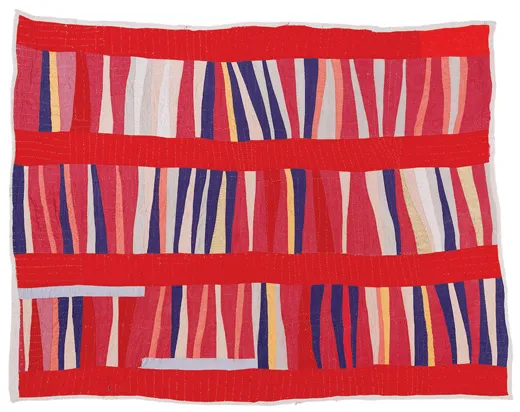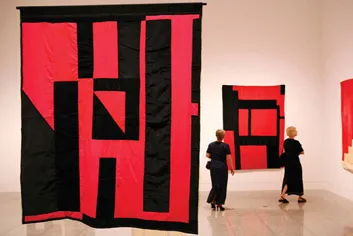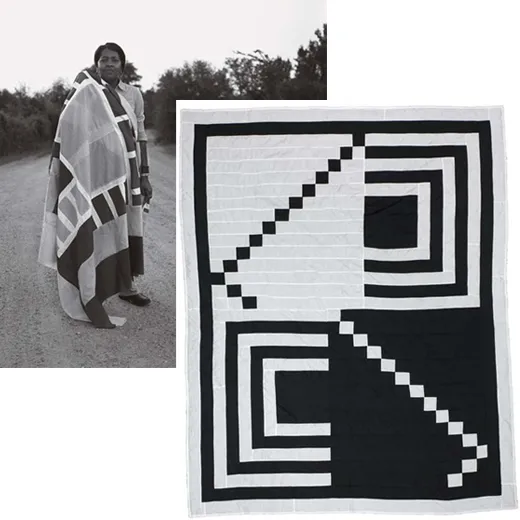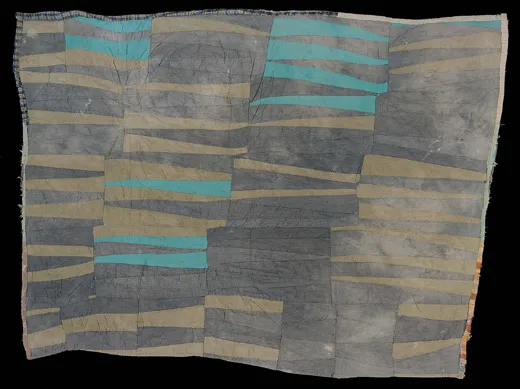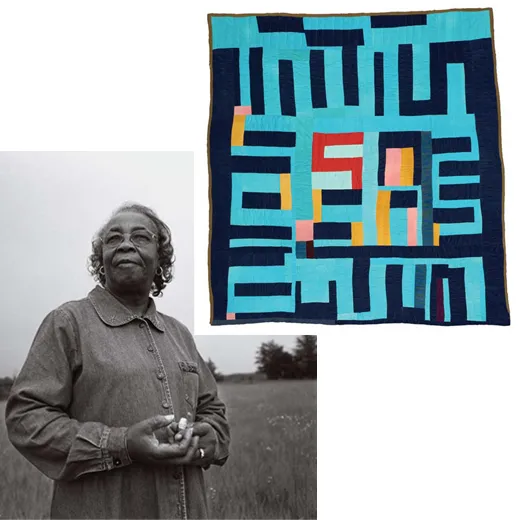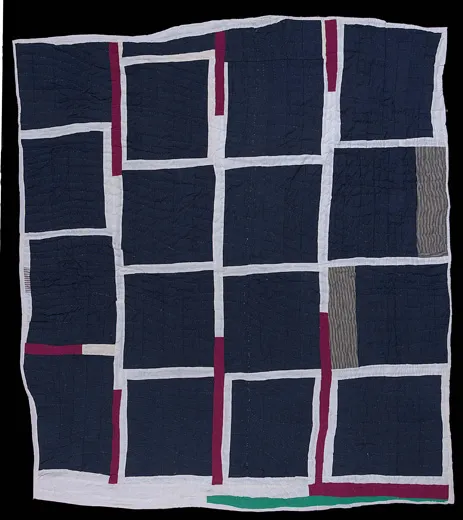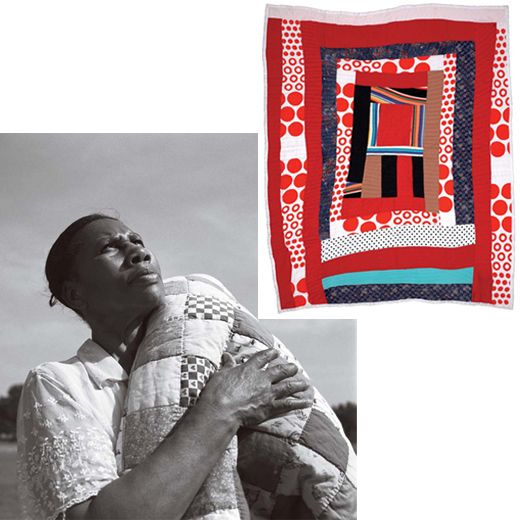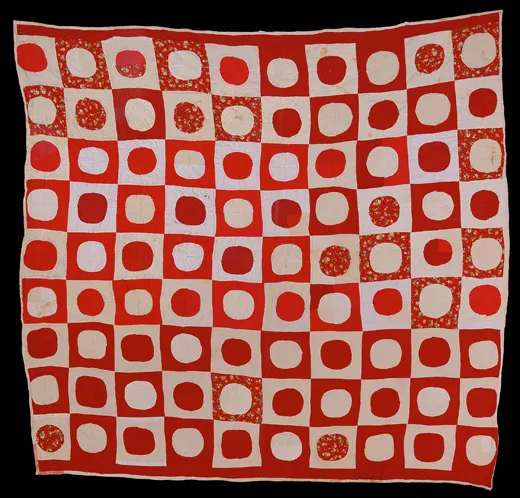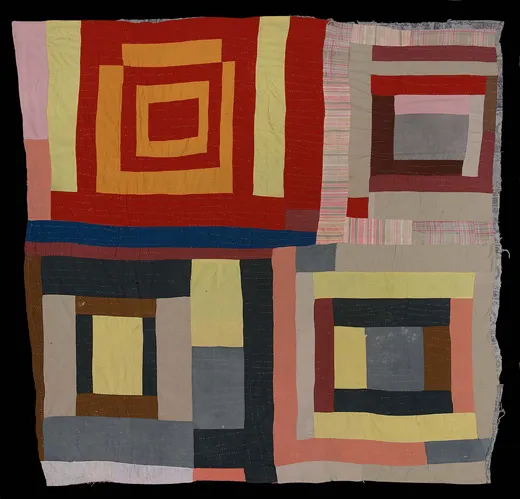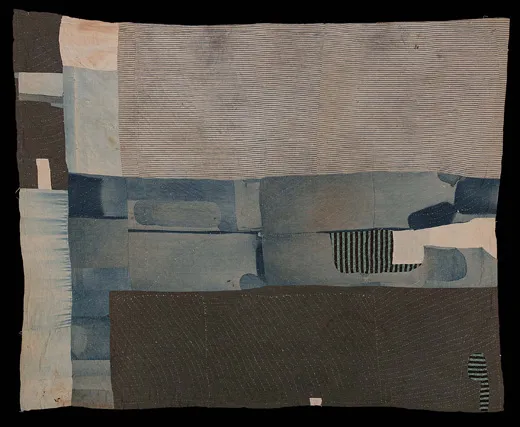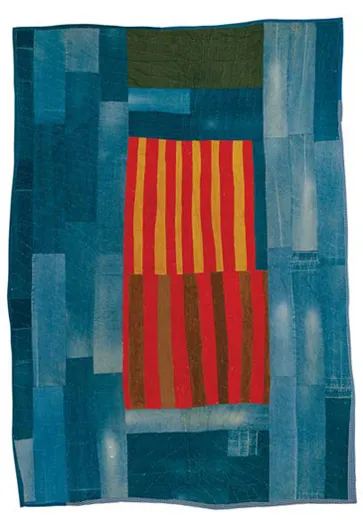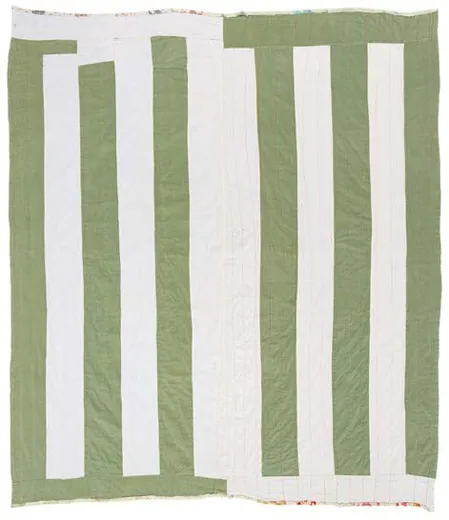Art Gallery Day Trip Winter Break Grazing Goats Fabric
Annie Mae Young is looking at a photograph of a quilt she pieced together out of strips torn from well-worn cotton shirts and polyester pants. "I was doing this quilt at the time of the civil rights movement," she says, contemplating its jazzy, free-grade squares.
Martin Luther Rex Jr. came to Young's hometown of Gee's Bend, Alabama, around that time. "I came over hither to Gee's Curve to tell you, You are somebody," he shouted over a heavy rain late 1 winter night in 1965. A few days later, Young and many of her friends took off their aprons, laid down their hoes and rode over to the county seat of Camden, where they gathered exterior the erstwhile jailhouse.
"We were waiting for Martin Luther Rex, and when he drove upwards, we were all slappin' and singin'," Young, 78, tells me when I visit Gee'southward Bend, a minor rural customs on a peninsula at a deep bend in the Alabama River. Wearing a red turban and an frock vivid with pinkish peaches and yellow grapes, she stands in the doorway of her brick bungalow at the terminate of a dirt road. Swaying to a rhythm that virtually everyone in town knows from a lifetime of churchgoing, she breaks into vocal: "Nosotros shall overcome, we shall overcome...."
"We were all only happy to see him coming," she says. "Then he stood out there on the ground, and he was talking most how nosotros should wait on a omnibus to come and we were all going to march. We got loaded on the bus, simply nosotros didn't get a hazard to do information technology, 'cause nosotros got put in jail," she says.
Many who marched or registered to vote in rural Alabama in the 1960s lost their jobs. Some even lost their homes. And the residents of Gee's Bend, 60 miles southwest of Montgomery, lost the ferry that continued them to Camden and a directly route to the outside world. "We didn't shut the ferry because they were black," Sheriff Lummie Jenkins reportedly said at the fourth dimension. "We closed it considering they forgot they were black."
Six of Young'due south quilts, together with 64 by other Gee'due south Bend residents, take been traveling around the United States in an exhibition that has transformed the mode many people remember about art. Gee's Curve's "eye-poppingly gorgeous" quilts, wrote New York Times art critic Michael Kimmelman, "turn out to be some of the most miraculous works of modern art America has produced. Imagine Matisse and Klee (if you lot think I'm wildly exaggerating, run into the show), arising not from rarefied Europe, but from the caramel soil of the rural South." Curator Jane Livingston, who helped organize the exhibition with collector William Arnett and fine art historians John Beardsley and Alvia Wardlaw, said that the quilts "rank with the finest abstract art of any tradition." After stops in such cities as New York, Washington, D.C., Cleveland, Boston and Atlanta, "The Quilts of Gee's Bend" will end its tour at the Fine Arts Museums of San Francisco's de Young Museum December 31.
The bold drama of the quilt Immature was working on in 1965 is also found in a quilt she made out of work clothes eleven years subsequently. The central blueprint of red and orange corduroy in that quilt suggests prison house bars, and the faded denim that surrounds it could be a comment on the American dream. But Young had more than practical considerations. "When I put the quilt together," she says, "it wasn't big plenty, and I had to get some more material and make it bigger, so I had these old jeans to make it bigger."
Collector William Arnett was working on a history of African-American vernacular art in 1998 when he came beyond a photograph of Young'due south work-apparel quilt draped over a woodpile. He was and so knocked out past its originality, he prepare out to detect it. A couple of phone calls and some artistic research later, he and his son Matt tracked Young downwards to Gee's Curve, then showed up unannounced at her door late i evening. Immature had burned some quilts the week earlier (smoke from called-for cotton drives off mosquitoes), and at beginning she thought the quilt in the photograph had been amid them. But the next mean solar day, after scouring closets and searching nether beds, she found it and offered it to Arnett for free. Arnett, however, insisted on writing her a bank check for a few k dollars for that quilt and several others. (Young took the check directly to the depository financial institution.) Soon the discussion spread through Gee's Curve that there was a crazy white man in boondocks paying skillful coin for raggedy old quilts.
When Arnett showed photos of the quilts made past Immature and other Gee's Benders to Peter Marzio, of the Museum of Fine Arts, Houston (MFAH), he was then impressed that he agreed to put on an exhibition. "The Quilts of Gee's Bend" opened in that location in September 2002.
The exhibition revived what had been a dying art in Gee's Bend. Some of the quilters, who had given in to historic period and arthritis, are at present back quilting again. And many of their children and grandchildren, some of whom had moved away from Gee'southward Bend, have taken upwardly quilting themselves. With the assistance of Arnett and the Tinwood Alliance (a nonprofit organization that he and his iv sons formed in 2002), fifty local women founded the Gee's Bend Quilters Collective in 2003 to market their quilts, some of which at present sell for more than $20,000. (Part goes straight to the maker, the rest goes to the commonage for expenses and distribution to the other members.)
Now a second exhibition, "Gee's Bend: The Compages of the Quilt," has been organized by the MFAH and the Tinwood Alliance. The show, which opened in June, features newly discovered quilts from the 1930s to the 1980s, along with more recent works past established quilters and the younger generation they inspired. The exhibition volition travel to 7 other venues, including the Indianapolis Museum of Art (October 8-Dec 31) and the Orlando Museum of Art (January 27-May 13, 2007).
Arlonzia Pettway lives in a smashing, recently renovated house off a route plagued with potholes. The road passes by cows and goats grazing outside robin's-egg blue and brown bungalows. "I call up some things, honey," Pettway, 83, told me. (Since my interview with her, Pettway suffered a stroke, from which she is all the same recovering.) "I came through a difficult life. Peradventure we weren't bought and sold, but we were yet slaves until 20, thirty years ago. The white man would go to everybody'southward field and say, 'Why yous not at piece of work?'" She paused. "What do y'all think a slave is?"
Every bit a daughter, Pettway would lookout her grandmother, Sally, and her female parent, Missouri, piecing quilts. And she would mind to their stories, many of them well-nigh Dinah Miller, who had been brought to the United states in a slave ship in 1859. "My neat-grandmother Dinah was sold for a dime," Pettway said. "Her dad, blood brother and mother were sold to different people, and she didn't meet them no more than. My bully-grandfather was a Cherokee Indian. Dinah was made to slumber with this big Indian similar you stud your moo-cow.... You couldn't have no skinny children working on your slave master's farm." In addition to Pettway, some 20 other Gee's Bend quiltmakers are Dinah's descendants.
The quilting tradition in Gee'southward Bend may go back every bit far as the early 1800s, when the community was the site of a cotton fiber plantation owned past a Joseph Gee. Influenced, perhaps, past the patterned textiles of Africa, the women slaves began piecing strips of cloth together to make bedcovers. Throughout the post-bellum years of tenant farming and well into the 20th century, Gee's Curve women made quilts to keep themselves and their children warm in unheated shacks that lacked running h2o, telephones and electricity. Along the mode they developed a distinctive style, noted for its lively improvisations and geometric simplicity.
Gee'southward Curve men and women grew and picked cotton, peanuts, okra, corn, peas and potatoes. When there was no coin to buy seed or fertilizer, they borrowed one or both from Camden businessman E. O. Rentz, at interest rates only those without whatever selection would pay. Then came the Low. In 1931 the price of cotton wool plummeted, from virtually xl cents a pound in the early on 1920s, to about a nickel. When Rentz died in 1932, his widow foreclosed on some sixty Gee's Curve families. It was late autumn, and winter was coming.
"They took everything and left people to die," Pettway said. Her female parent was making a quilt out of one-time clothes when she heard the cries outside. She sewed four broad shirttails into a sack, which the men in the family filled with corn and sweet potatoes and hid in a ditch. When the agent for Rentz's widow came around to seize the family unit's hens, Pettway'south female parent threatened him with a hoe. "I'm a adept Christian, but I'll chop his damn brains out," she said. The human being got in his wagon and left. "He didn't get to my mama that twenty-four hour period," Pettway told me.
Pettway remembered that her friends and neighbors foraged for berries, hunted possum and squirrels, and mostly went hungry that winter until a boat with flour and repast sent by the Crimson Cross arrived in early on 1933. The following year, the Federal Emergency Relief Assistants provided small loans for seed, fertilizer, tools and livestock. Then, in 1937, the authorities'south Resettlement Assistants (after the Farm Security Administration) bought up 10,000 Gee'southward Bend acres and sold them as tiny farms to local families.
In 1941, when Pettway was in her late teens, her father died. "Mama said, 'I'm going to take his work clothes, shape them into a quilt to recollect him, and cover upward under it for dearest.'" There were inappreciably enough pants legs and shirttails to make up a quilt, but she managed. (That quilt—jostling rectangles of faded gray, white, bluish and red—is included in the first exhibition.) A year later, Arlonzia married Bizzell Pettway and moved into one of the new houses congenital by the government. They had 12 children, but no electricity until 1964 and no running h2o until 1974. A widow for more than thirty years, Arlonzia still lives in that same house. Her mother, Missouri, who lived until 1981, made a quilt she called "Path Through the Woods" after the 1960s liberty marches. A quilt that Pettway pieced together during that flow, "Chinese Coins", is a medley of pinks and purples—a friend had given her imperial scraps from a clothing factory in a nearby boondocks.
"At the time I was making that quilt, I was feeling something was going to happen improve, and it did," Pettway says. "Last time I counted I had 32 grandchildren and I remember between 13 and fourteen great-grands. I'm blessed now more than many. I have my abode and land. I have a deepfreeze 5 feet long with chicken wings, neck bones and pork chops."
The beginning exhibition featured seven quilts by Loretta Pettway, Arlonzia Pettway's first cousin. (One in iii of Gee's Bend's 700 residents is named Pettway, later slave owner Mark H. Pettway.) Loretta, 64, says she fabricated her early quilts out of work clothes. "I was near 16 when I learned to quilt from my grandmama," she says. "I just loved it. That's all I wanted to do, quilt. But I had to piece of work farming cotton fiber, corn, peas and potatoes, making syrup, putting upward soup in jars. I was working other people'southward fields also. Saturdays I would rent out; sometimes I would hire out Sundays, too, to give my kids some nutrient. When I finished my chores, I'd sit down and practice like I'chiliad doing now, get the wearing apparel together and tear them and piece. So in summer I would quilt outside nether the big oak." She fingers the fabric pieces in her lap. "I thank God that people want me to make quilts," she says. "I feel proud. The Lord lead me and guide me and give me strength to brand this quilt with beloved and peace and happiness so somebody would enjoy it. That makes me feel happy. I'm doing something with my life."
In 1962 the U.Due south. Congress ordered the construction of a dam and lock on the Alabama River at Miller's Ferry, just due south of Gee'due south Bend. The 17,200-acre reservoir created past the dam in the late 1960s flooded much of Gee's Bend'south all-time farming land, forcing many residents to give up farming. "And thank God for that," says Loretta. "Farming wasn't nothing but hard work. And at the end of the twelvemonth you couldn't get nothing, and the little you lot got went for cottonseed."
Around that fourth dimension, a number of Gee'due south Bend women began making quilts for the Liberty Quilting Bee, founded in 1966 by civil rights worker and Episcopalian priest Francis X. Walter to provide a source of income for the local customs. For a while, the bee (which operated for about 3 decades) sold quilts to such stores as Bloomingdale'due south, Sears, Saks and Bonwit Teller. But the stores wanted assembly-line quilts, with orderly, familiar patterns and precise stitching—not the individual, ofttimes improvised and unexpected patterns and color combinations that characterized the Gee'south Bend quilts.
"My quilts looked beautiful to me, because I made what I could brand from my head," Loretta told me. "When I start I don't want to end until I end, because if I finish, the ideas are going to go i way and my mind another way, and so I simply effort to do it while I have ideas in my mind."
Loretta had been likewise ill to attend the opening of the showtime exhibition in Houston. Merely she wore a bright blood-red jacket and a wrist corsage of roses to the opening of the second testify last spring. Going there on the passenger vehicle, "I didn't shut my optics the whole mode," she says. "I was so happy, I had to sightsee." In the new show, her 2003 take on the pop "Housetop" blueprint—a variant of the traditional "Log Cabin" blueprint—is an explosion of red polka dots, zany stripes and crooked frames within frames (a dramatic alter from the faded colors and somber patterns of her early work-clothes quilts). Ii other quilts made by Loretta are amid those represented on a series of Gee's Bend stamps issued this by August by the U.S. Postal service. "I but had scraps of what I could find," she says about her early on piece of work. "Now I see my quilts hanging in a museum. Thank God I run into my quilts on the wall. I found my way."
Mary Lee Bendolph, 71, speaks in a husky voice and has a hearty, throaty express mirth. At the opening of the new exhibition in Houston, she sported large rhinestone earrings and a chic blackness apparel. For some years, kidney disease had slowed her quiltmaking, but the first exhibition, she says, "spunked me to go a little further, to attempt and make my quilts a niggling more updated." Her latest quilts fracture her lawn views and other local scenes the way Cubism fragmented the cafés and countryside of France. Her quilts share a gallery with those of her daughter-in-law, Louisiana Pettway Bendolph.
Louisiana now lives in Mobile, Alabama, merely she remembers hot, countless days picking cotton equally a child in the fields around Gee'south Bend. From historic period 6 to 16, she says, the only time she could get to school was when it rained, and the just play was softball and quiltmaking. Her mother, Rita Mae Pettway, invited her to the opening in Houston of the first quilt show. On the bus ride home, she says, she "had a kind of vision of quilts." She made drawings of what would become the quilts in the new exhibition, in which shapes seem to float and recede as if in 3 dimensions.
"Quilting helped redirect my life and put it back together," Louisiana says. "I worked at a fast-food place and a sewing factory, and when the sewing factory airtight, I stayed habitation, being a housewife. You just desire your kids to see you lot in a different light, as someone they can admire. Well, my children came into this museum, and I saw their faces."
To Louisiana, 46, quiltmaking is history and family. "Nosotros think of inheriting as state or something, not things that people teach you lot," she says. "We came from cotton fields, nosotros came through hard times, and nosotros look back and see what all these people before us have washed. They brought united states here, and to say cheers is not enough." At present her xi-year-old granddaughter has taken up quiltmaking; she, however, does her drawings on a computer.
In Gee'south Curve not long agone, her cracking-grandmother Mary Lee Bendolph picked some pecans to make into processed to have on hand for the children when the just store in town is closed, which it often is. Then she soaked her feet. Sitting on her screened-in porch, she smiled. "I'thou famous," she said. "And look how former I am." She laughed. "I enjoy information technology."
Source: https://www.smithsonianmag.com/arts-culture/fabric-of-their-lives-132757004/
